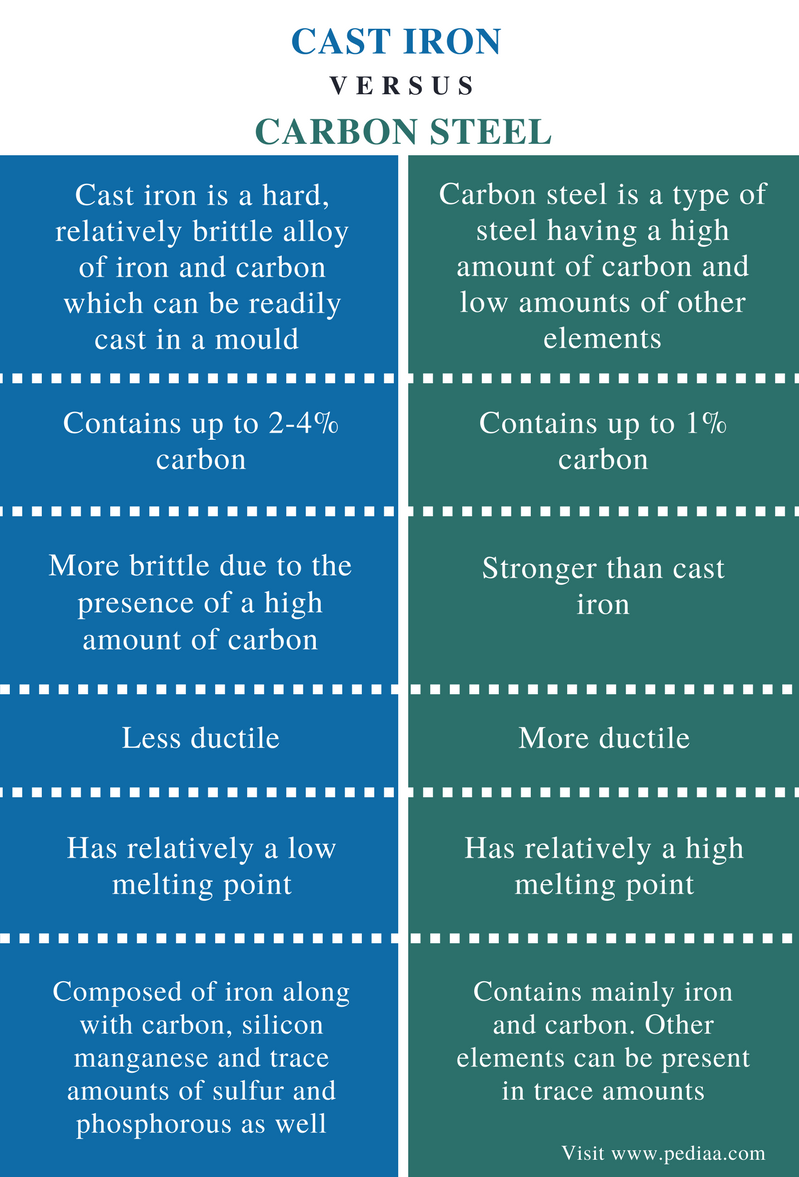
Carbon steel contains less carbon than cast iron and its thin lightweight and smooth. This is more a review of carbon steel as a material from a toxicity stand point and a comparison to the pan which is most similar to it and which I love cast iron.

Cast iron is an alloy of carbon and iron like steel but with more carbon in it compared to steel.
Carbon steel and cast iron. Cast iron is actually an alloy of iron and carbon just like steel with the main difference being that cast iron has more carbon in it. Whereas steel requires a carbon content of no more than 2 percent cast iron usually contains 2 to 35 percent carbon. Its the carbon content that gives cast iron its rough slightly bumpy feel.
Heat Distribution and Retention. Heats relatively slowly but retains heat like a champ in large part because of its thickness. In comparison to cast iron carbon steel is much more responsive to heat.
It also cools faster than cast iron. Carbon steel contains less carbon than cast iron and its thin lightweight and smooth. Its more heat conductive so it heats up fast and even and has few hot spots.
The smooth surface makes it more nonstick than cast iron. It can be as slick as a nonstick pan when seasoned properly. Cast iron has a higher carbon content than carbon steel.
Carbon Steel vs Cast Iron Comparison Pros and Cons Carbon Steel. Carbon steels are ironcarbon alloys that may contain appreciable concentrations of other alloying. Gray cast iron have also an excellent damping capacity which is given by the graphite because it.
The main difference between cast iron and cast steel valves is the carbon content which directly affects the strength and plasticity of the steel. Carbon steel is also called carbon steel an iron-carbon alloy with a carbon content of less than 2 WC. In addition to carbon carbon steel generally contains a small amount of silicon manganese.
Difference Between Cast Iron and Carbon Steel Definition. Cast iron is a hard relatively brittle alloy of iron and carbon which can be readily cast in a mould and contains a higher proportion of carbon than steel. Carbon steel is a type of steel having a high amount of carbon and low amounts of other elements.
Cast iron contains up to 2-4 carbon. Cast Iron And Steel Carbon Content The most notable difference between steel and cast iron is the carbon content. Cast iron has a carbon content greater than 2 while steel has a carbon content of less than 2 with many steel alloys having less than 1.
Cast iron usually refers to gray iron ductile iron and malleable iron. Which is an iron casting with carbon content higher than 2. Cast steel usually refers to normal carbon steel and alloy steel.
Which is a steel casting with carbon content lower than 2. Therefore no big difference from the chemical content and raw materials for cast iron vs cast steel. Both Cast iron and Cast steel are ferrous products containing iron and carbon as the major components.
Cast iron is a ferrous material containing more than 2 carbon. On the other hand Cast steel contains less than 2 carbon. So composition-wise the main difference is the amount of carbon present in cast iron and steel.
Cast iron cast carbon steel and types of iron castings can look similar but the metallurgy will be different. Not all cast iron is the same either. Gray iron and ductile iron will act differently.
This process allows them to be lighter and thinner than cast iron. Carbon steel pans heat up and cool down faster. While cast iron is slow to heat up carbon steel pans reach the ideal cooking temperature quickly.
The slight bow in the carbon steel cookware allows the pan to cool down quickly. Iron products are mainly classified as Steel Cast-iron and Wrought iron. The differences in their properties are due to the different amounts of carbon they contain.
Smaller the amount of carbon in steel nearer will its properties be to those of wrought iron and greater the quantity of carbon Steel would resemble the cast-iron. Carbon steel cookware like this skillet from Misen is made from an alloy aka a mixture of two or more metals or a metal combined with another element. In this case its carbon and iron.
Cast steel is iron-carbon alloy with carbon content below 211. Cast steel has good comprehensive performance weld-ability and workability but it has bad shake-suction and casting performance compared to cast iron. Cast steel can be divided into cast carbon steel cast low alloy steel and cast special steel according to chemical.
This is more a review of carbon steel as a material from a toxicity stand point and a comparison to the pan which is most similar to it and which I love cast iron. Typically comprised of about 99 iron and 1 steel. Typically comprised of 97-98 iron and 2-3 steel.
Cast iron is an alloy of carbon and iron like steel but with more carbon in it compared to steel. Cast iron contains 2-35 carbon compared with 1-2 only in steel. The carbon gives the cast iron its rough feel and makes it more fragile than steel.
The volume covers cast irons carbon and low-alloy steels tool steels and stainless steels as well as aluminum titanium and precious-metal alloys. It also covers ceramics and cemented carbides. The difference between cast steel VS carbon steel.
Cast steel is a kind of casting alloy. Iron and carbon are the main elements. The carbon content is between 0-2.
Carbon steel is an iron-carbon alloy with a carbon content of 00218 to 211.